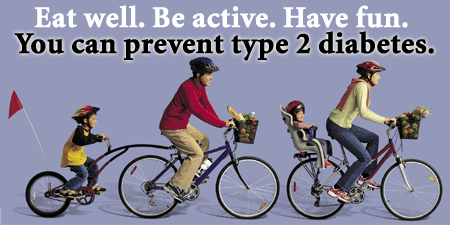![]()



|
|
||||||||||||


 |
|
|||||||||||

|

Information Kit - Type 2 DiabetesType 2 diabetes occurs when insulin continues to be produced but is not properly used in the body. In recent years, more and more cases of type 2 diabetes are being diagnosed in young people, especially those of Aboriginal descent. Those with a family history of obesity and those who are inactive are also at risk for developing type 2 diabetes. Symptoms of type 2 diabetes include:
A person may also present with the complications of diabetes to their physician. These can include:
Managing the diseaseRegular physical activity and weight control are often crucial components of therapy for type 2 diabetes and oral medications and/or insulin injections may be required. Some people with type 2 diabetes need to use insulin to achieve good blood glucose control. Early and tight control of blood sugar levels combined with control of high blood pressure and blood lipids can reduce the risk of complications.Risk factorsA number of known risk factors have been identified for type 2 diabetes. These include: . obesity . having an apple shaped body figure . age . leading a sedentary lifestyle . family history . history of gestational diabetes or birth of a baby over 4 kg (9 lbs) . impaired glucose intolerance . being of Aboriginal, African, Latin American or Asian ethnic ancestry . high blood pressure . high cholesterolwww.diabetes.gc.ca© Her Majesty the Queen in Right of Canada, (2002) ISBN 0-662-66546-5 |
|
|||||||